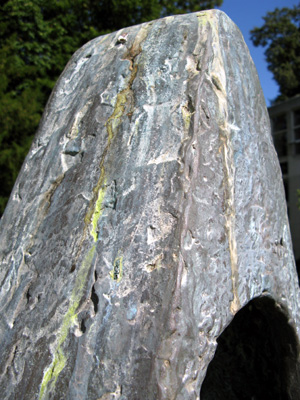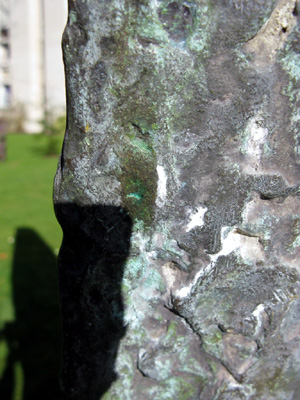
The sculpture before treatment showing various surface colours on the bronze

Streaks of bird lime at the top of the sculpture

The back of the sculpture before treatment showing a dry, unwaxed surface

Detail of the bronze surface showing white residues in crevices and some biological growth

An image of the sculpture when it was first made, with a white patina (image taken by Studio St Ives © Bowness, kindly supplied by the Hepworth Estate)

Carefully washing the surface to preserve any existing white residues

Detail of the surface with a white reversible tinted wax applied to simulate the original appearance

The sculpture after several years of annual maintenance

Dame Barbara Hepworth
'Ascending Form (Gloria)' 1958
When we first examined this sculpture at the request of the Hepworth Estate there were colours on the surface that were unusual for an outdoor bronze. Closer examination revealed that there was a white material in many of the crevices surrounded by various colours of algae.
The Hepworth Estate kindly allowed us access to their photographic archives which showed that many casts of this sculpture originally had a white surface finish. With this in mind the sculpture was carefully surface cleaned and further white material was revealed suggesting that this cast would indeed have had a white finish over its entire surface but that much of this had been lost as a result of weathering over time.
Hepworth was adventurous in the use of patinas on bronze and worked closely with her foundry to achieve the colours and effects she wanted. These were often to emphasise contrast in her forms though her use of this kind of white finish on bronzes was extremely radical for the date. Documentary sources suggest that the Art Bronze Foundry (who cast the edition) created this effect with ‘white paint and the remains of white from the investment (the mould from casting bronzes)’ [1].
Although there was a great deal of the original white finish still remaining the overall visual effect was fragmentary overall. The treatment aimed to enhance the existing white with a white tinted wax to unify the surface. This sculpture is now maintained annually to clean the surface and replenish the tinted wax as required. The wax has the effect of bringing the sculpture’s appearance closer to that intended by the artist whilst being completely reversible.
[1] ‘Barbara Hepworth The Plasters: The Gift to Wakefield’ Ed Sophie Bowness. Lund Humphries. 2011
Artist | Dame Barbara Hepworth |
|---|---|
Name | 'Ascending Form (Gloria)' 1958 |
Client | Murray Edwards College |
Location | Cambridge |